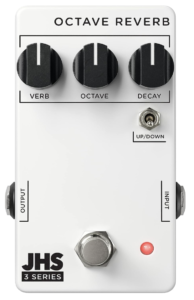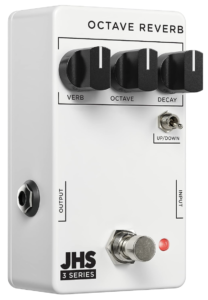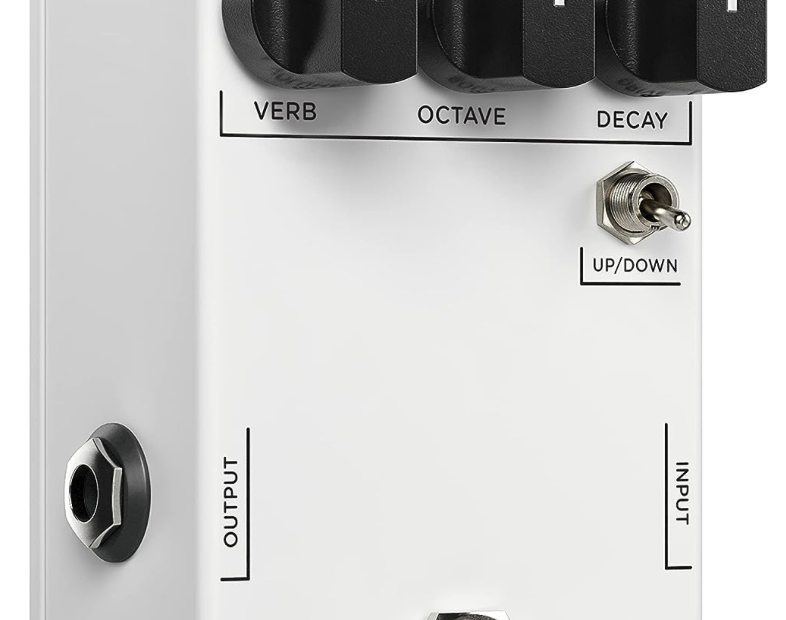JHS Pedals 3 Series Octave Reverb is a guitar effects pedal that combines reverb with an octave-up effect, providing players with a unique and creative sound palette.
JHS Pedals is known for its high-quality effects pedals, and the 3 Series offers a more budget-friendly option while retaining the brand’s commitment to sound and build quality.
Here are some key features and characteristics of the JHS Pedals 3 Series Octave Reverb:
 Reverb Effect
Reverb Effect
The pedal features a reverb effect that adds ambience and spaciousness to your guitar sound. Reverb simulates the natural reverberation of a room or space, allowing you to achieve lush and atmospheric tones.
The reverb effect in the JHS Pedals 3 Series Octave Reverb is a fundamental audio processing feature that simulates the natural reverberation of a room or space. Reverb adds ambience, depth, and spaciousness to your guitar sound, creating a sense of sonic environment and immersion. In the context of the JHS Pedals 3 Series Octave Reverb, the reverb effect can be blended with other effects, such as the octave-up effect, to create unique and expressive tones.
Key characteristics of the reverb effect in the JHS Pedals 3 Series Octave Reverb include:
- Ambience and Depth: Reverb adds a sense of space and depth to your guitar sound. It can make your playing sound as if it’s occurring in a specific environment, such as a small room, a large hall, or an expansive canyon.
- Atmosphere and Texture: The reverb effect contributes to the overall atmosphere and texture of your sound. It can make your guitar tones more lush, ethereal, and dreamy, enhancing your playing with a three-dimensional quality.
- Control Parameters: The reverb effect on the pedal is typically controlled using the “Reverb” knob. Turning this knob clockwise increases the level or intensity of the reverb effect, adding more reverb to your sound.
- Blend Control: The “Blend” knob allows you to adjust the balance between the dry (original) guitar signal and the reverb effect. This control is essential for dialing in the amount of reverb you want in your sound. Turning the knob clockwise increases the mix of reverb.
- Expression Pedal (if applicable): Some versions of the pedal may allow you to control the reverb parameters using an expression pedal. This provides real-time control over the reverb level, enabling dynamic changes during your performance.
- Reverb Types: Different reverb pedals offer various reverb algorithms or types, such as hall, plate, spring, and more. The JHS Pedals 3 Series Octave Reverb may offer a specific reverb algorithm that contributes a particular tonal character to the effect.
Also Read:
Digitech DOD Meatbox Pedal Review
Source Audio C4 Synth Pedal Review
MOOER Acoustikar Acoustic Guitar Simulator Pedal
Boss GT-1 Guitar Multi-effects Pedal
LEKATO Multi Effects Guitar Pedal
Best Multi effects Pedal for Guitar: Review
 Creative Uses and Tips
Creative Uses and Tips
- Subtle Depth: Use a touch of reverb to add a subtle sense of space and depth to your clean or lightly overdriven tones. This can help create a natural and open sound.
- Ambient Soundscapes: Increase the reverb level for creating ambient soundscapes, swells, and pad-like textures. Combining reverb with the octave-up effect can yield otherworldly and evolving tones.
- Enhance Solos: Apply reverb to your lead guitar parts to make them stand out and sound more expressive. Experiment with longer decay times for a dramatic effect.
- Mixing with Octave-Up: Adjust the blend between reverb and octave-up effects to find an interesting balance. This can lead to creative and unique sounds that blend space with harmonics.
Other Features
The octave-up effect is a feature that generates a pitch-shifted note one octave higher than the original input. This can create a harmonically rich sound reminiscent of an organ or synth-like texture.
The pedal allows you to blend the reverb effect with the octave-up effect. This means you can combine the atmospheric qualities of reverb with the unique octave-up tonal character.
The pedal typically features controls for adjusting the level of the reverb, the level of the octave-up effect, and the blend between the two effects. These controls provide flexibility in shaping your sound.
 True Bypass Switching
True Bypass Switching
True bypass switching ensures that the pedal’s circuitry does not interfere with your guitar’s signal when the effect is disengaged, maintaining the integrity of your tone.
The JHS Pedals 3 Series pedals are designed to be compact and pedalboard-friendly, conserving space on your pedalboard.
Rugged Construction: JHS Pedals are known for their durable and reliable build quality, ensuring that the pedal can withstand the rigors of live performances and studio use.
Affordability: The 3 Series from JHS Pedals is designed to offer quality effects at a more affordable price point compared to their flagship models, making them accessible to a wider range of players.
How to Use the Pedal
Here’s a basic overview of how you might use the pedal:
Setup:
- Power: Connect the JHS Pedals 3 Series Octave Reverb to a suitable power source using a compatible power supply.
- Input and Output: Connect your guitar to the input of the pedal using a standard instrument cable. Connect the output of the pedal to your amplifier or other sound system.
- Bypass: Ensure the pedal is in bypass mode (effect turned off) if you’re not using the effect.
 Using the Reverb Effect:
Using the Reverb Effect:
- Reverb Level: Turn the “Reverb” knob clockwise to increase the level of the reverb effect. This will add more ambient and spacious sound to your guitar tone.
- Blend: The “Blend” knob adjusts the mix between your dry (original) guitar signal and the reverb effect. Turn it clockwise for more reverb, and counterclockwise for a more subtle effect.
Using the Octave-Up Effect:
- Octave Level: Turn the “Octave” knob clockwise to increase the level of the octave-up effect. This will add a higher-pitched octave to your sound.
- Blend: The “Blend” knob in this context adjusts the mix between your dry signal and the octave-up effect. Similar to the reverb blend, turn it clockwise for more octave-up effect, and counterclockwise for a more balanced sound.
Combining Reverb and Octave-Up:
- Experiment with different combinations of reverb and octave-up levels. For example:
- To create a dreamy, atmospheric sound, increase both the reverb and octave levels.
- For a more subtle texture, increase the reverb level and keep the octave level lower.
- To emphasize the octave-up effect, reduce the reverb level and increase the octave level.
- Adjust the “Blend” control to find the right balance between the two effects. This will help you achieve the desired tonal character and level of effect intensity.
 Expression Pedal (if applicable):
Expression Pedal (if applicable):
If the JHS Pedals 3 Series Octave Reverb has an expression pedal input, you can use an expression pedal to control parameters such as the blend between reverb and octave-up or the overall effect level. Consult the user manual for specific instructions on how to set up and use an expression pedal with the pedal.
Final Tips:
Remember that pedals’ controls can interact with each other, so take time to explore and experiment with different settings to find the sounds that work best for your playing style and musical context. For specific details, tips, and safety instructions, always refer to the user manual provided by JHS Pedals.
